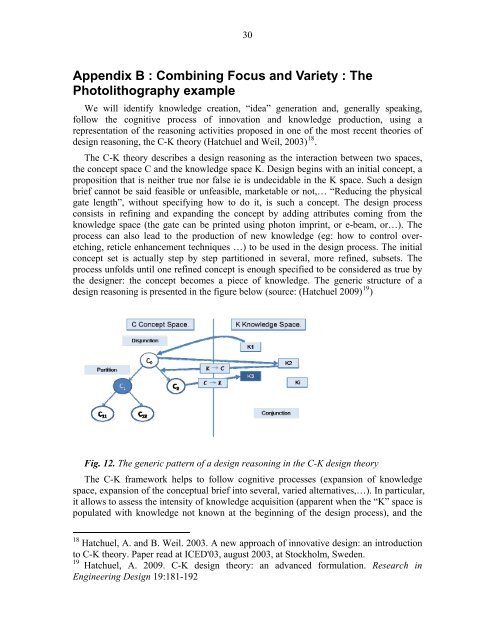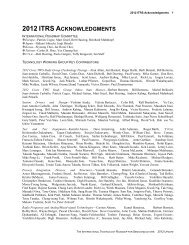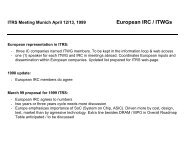More than Moore White Paper - ITRS
More than Moore White Paper - ITRS
More than Moore White Paper - ITRS
You also want an ePaper? Increase the reach of your titles
YUMPU automatically turns print PDFs into web optimized ePapers that Google loves.
Appendix B : Combining Focus and Variety : The<br />
Photolithography example<br />
30<br />
We will identify knowledge creation, “idea” generation and, generally speaking,<br />
follow the cognitive process of innovation and knowledge production, using a<br />
representation of the reasoning activities proposed in one of the most recent theories of<br />
design reasoning, the C-K theory (Hatchuel and Weil, 2003) 18 .<br />
The C-K theory describes a design reasoning as the interaction between two spaces,<br />
the concept space C and the knowledge space K. Design begins with an initial concept, a<br />
proposition that is neither true nor false ie is undecidable in the K space. Such a design<br />
brief cannot be said feasible or unfeasible, marketable or not,… “Reducing the physical<br />
gate length”, without specifying how to do it, is such a concept. The design process<br />
consists in refining and expanding the concept by adding attributes coming from the<br />
knowledge space (the gate can be printed using photon imprint, or e-beam, or…). The<br />
process can also lead to the production of new knowledge (eg: how to control overetching,<br />
reticle enhancement techniques …) to be used in the design process. The initial<br />
concept set is actually step by step partitioned in several, more refined, subsets. The<br />
process unfolds until one refined concept is enough specified to be considered as true by<br />
the designer: the concept becomes a piece of knowledge. The generic structure of a<br />
design reasoning is presented in the figure below (source: (Hatchuel 2009) 19 )<br />
Fig. 12. The generic pattern of a design reasoning in the C-K design theory<br />
The C-K framework helps to follow cognitive processes (expansion of knowledge<br />
space, expansion of the conceptual brief into several, varied alternatives,…). In particular,<br />
it allows to assess the intensity of knowledge acquisition (apparent when the “K” space is<br />
populated with knowledge not known at the beginning of the design process), and the<br />
18<br />
Hatchuel, A. and B. Weil. 2003. A new approach of innovative design: an introduction<br />
to C-K theory. <strong>Paper</strong> read at ICED'03, august 2003, at Stockholm, Sweden.<br />
19<br />
Hatchuel, A. 2009. C-K design theory: an advanced formulation. Research in<br />
Engineering Design 19:181-192




